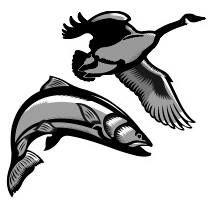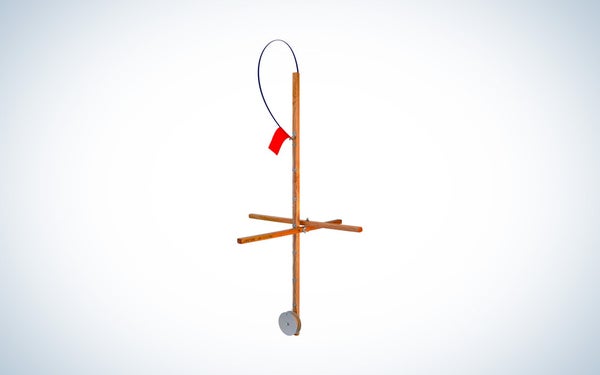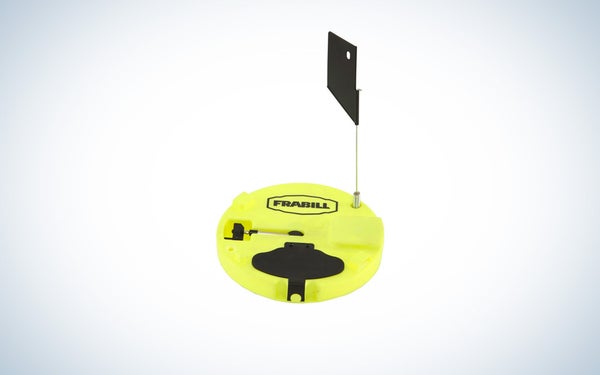



A tip-up, also known as a fish trap, ice trap, or tilt, is a stationary device that suspends line and live bait under the ice. Once a fish takes the bait, the reel spins, and the angler is alerted of a bite via a brightly colored flag springing into the air. While styles may vary, most models feature a reel that sits inside of the hole.
Tip-ups are an extremely effective way to cover water and dial in on a specific bite. Although the concept is pretty straightforward, there are a few different designs, with some being more popular than others. But no matter which one you use, the idea is the same: more baits in the water mean more chances at fish. Here’s everything you need to know to start tip-up ice fishing.

You can use a tip-up in most ice fishing scenarios, but I tend to lean heavily on tip-ups when trying to break down a large piece of structure, such as a defined weed edge, drop-off, or underwater hump. While other ice-fishing strategies force an ice angler to focus on one hole at a time, tip-ups give you the chance to fish multiple holes with relative ease. This allows anglers to set rigs in different areas without having to attend to the line constantly. The number of tip-ups that can be used by an angler varies drastically by state. Before hitting the ice, make sure to check local regulations.
Like most fishing pursuits, different regions have different styles of rigs and tactics. The hard water is no different. These are three of the most common tip-up rigs you’ll find on the ice:
Popular across the Northeast section of the ice belt, the cross-stick design is comprised of three wooden rails. Two horizontal rails intersect to make a cross (hence the name), which is the portion that rests on the ice. The third rail runs vertically, with a reel located on the bottom end. The flag is attached to the end of a light piece of metal, which runs parallel over the top of the vertical rail. The flag is then bent over and hooked on a metal “tripper” which is connected to a piece of light wire that continues down to the reel. Once a fish begins to move the reel, a tab hits the light wire, pushing the flag off the “tripper,” indicating a fish is on the line.

A favorite throughout the Midwest, the plank design is very simple. It features a flat piece of wood that runs across the hole with a cutout in the middle containing a rotating metal shaft with a “T” on the top and a reel on the bottom. On one end of the board, a flag beam is connected via a spring. The flag is set by positioning the beam under the “T.” As a fish takes the bait and turns the reel, the shaft spins, and the flag pops up to let the angler know a fish is on.

Comprised of a similar tripping mechanism as the plank design, the insulated tip-up has a body that covers the entire hole. These models often feature heavy insulation to prevent the holes from freezing and keep them clear of drifting snow.
With live bait being the presentation of choice, tip-up rigging is incredibly simple. Begin by spooling the reel with a heavy-duty Dacron ice fishing line. From there, tie on a lengthy section of fluorocarbon leader material connected to the main line via a barrel swivel. Lastly, an octopus hook and split shot are added to round out the rigging. While fluorocarbon is great for species like trout and walleye, steel leaders are mandatory when chasing toothy critters such as big pike.
While tip-ups are great for covering different sections of the ice, there are other things that can be done to increase bites. Use these three tips to hook more fish on your tip-ups:
Specs
Made in Maine, the Big Bob from Jack Traps is the ultimate tool for the big water ice angler. Like all Jack Traps, this model features a windproof tripping mechanism to ensure zero wind flags during blustery days on the ice. Additionally, this product is designed with high visibility in mind, as the Big Bob stands almost five feet above the ice.
Specs
Frabill has long been a name synonymous with ice fishing. The Pro Thermal model is designed to be transported with ease as it fits into a five-gallon bucket. Additionally, the heavily insulated body eliminates the hassle of frozen holes. A top pick for nighttime crappie or walleye missions, the Pro Thermal model comes standard with a bright red LED light that begins flashing when the flag is triggered.
Tip-ups are a timeless ice fishing tactic that is responsible for a lot of success on the hard water. They also happen to be a fantastic way to introduce young people to the sport since they don’t require constant attention or extreme focus. And as most seasoned anglers can attest, there’s nothing quite like the thrill of a flag.



